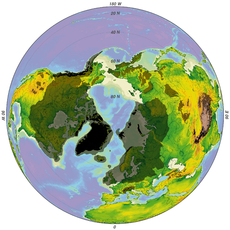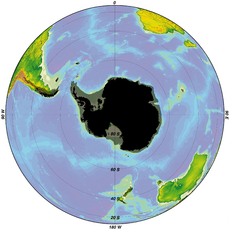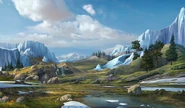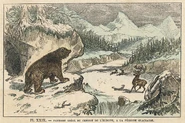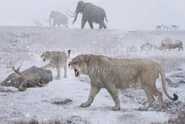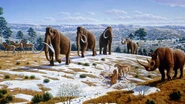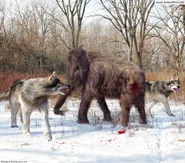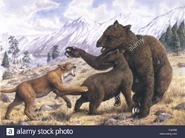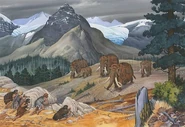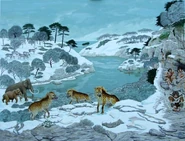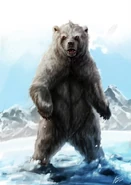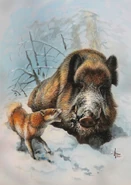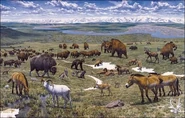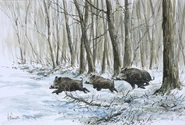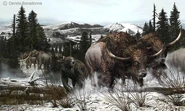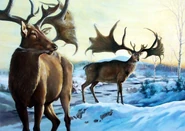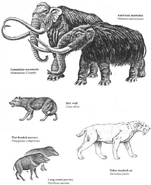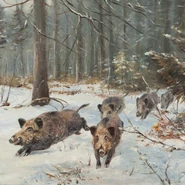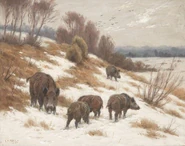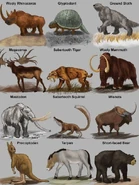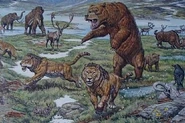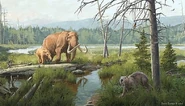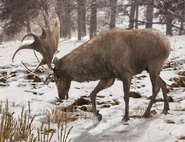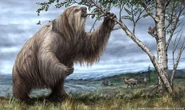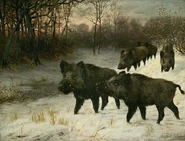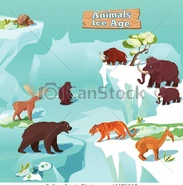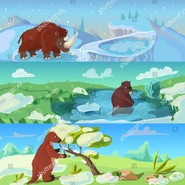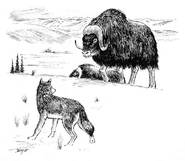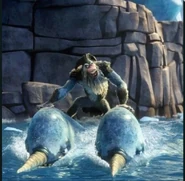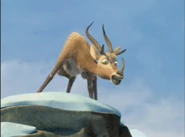
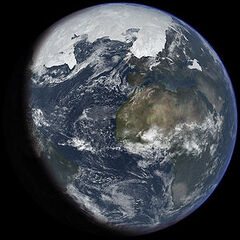
An artist's impression of ice age Earth at glacial maximum.
An ice age is a long period of reduction in the temperature of the Earth's surface and atmosphere, resulting in the presence or expansion of continental and polar ice sheets and alpine glaciers. Earth's climate alternates between ice ages and greenhouse periods, during which there are no glaciers on the planet. Earth is currently in the Quaternary glaciation, known in popular terminology as the Ice Age.[1] Individual pulses of cold climate within an ice age are termed "glacial periods" (or, alternatively, "glacials", "glaciations", "glacial stages", "stadials", "stades", or colloquially, "ice ages"), and intermittent warm periods within an ice age are called "interglacials" or "interstadials", with both climatic pulses part of the Quaternary or other periods in Earth's history.[2]
In the terminology of glaciology, ice age implies the presence of extensive ice sheets in both northern and southern hemispheres.[3] By this definition, we are in an interglacial period—the Holocene. The amount of heat trapping gases emitted into Earth's oceans and atmosphere are predicted to prevent the next glacial period, which otherwise would begin in around 50,000 years, and likely more glacial cycles.[4][5]
Evidence for ice ages[]
There are three main types of evidence for ice ages: geological, chemical, and paleontological.
Geological evidence for ice ages comes in various forms, including rock scouring and scratching, glacial moraines, drumlins, valley cutting, and the deposition of till or tillites and glacial erratics. Successive glaciations tend to distort and erase the geological evidence, making it difficult to interpret. Furthermore, this evidence was difficult to date exactly; early theories assumed that the glacials were short compared to the long interglacials. The advent of sediment and ice cores revealed the true situation: glacials are long, interglacials short. It took some time for the current theory to be worked out.
The chemical evidence mainly consists of variations in the ratios of isotopes in fossils present in sediments and sedimentary rocks and ocean sediment cores. For the most recent glacial periods ice cores provide climate proxies from their ice, and atmospheric samples from included bubbles of air. Because water containing heavier isotopes has a higher heat of evaporation, its proportion decreases with colder conditions.[6] This allows a temperature record to be constructed. This evidence can be confounded, however, by other factors recorded by isotope ratios.
The paleontological evidence consists of changes in the geographical distribution of fossils. During a glacial period cold-adapted organisms spread into lower latitudes, and organisms that prefer warmer conditions become extinct or are squeezed into lower latitudes. This evidence is also difficult to interpret because it requires (1) sequences of sediments covering a long period of time, over a wide range of latitudes and which are easily correlated; (2) ancient organisms which survive for several million years without change and whose temperature preferences are easily diagnosed; and (3) the finding of the relevant fossils.
Despite the difficulties, analysis of ice core and ocean sediment cores[7] has shown periods of glacials and interglacials over the past few million years. These also confirm the linkage between ice ages and continental crust phenomena such as glacial moraines, drumlins, and glacial erratics. Hence the continental crust phenomena are accepted as good evidence of earlier ice ages when they are found in layers created much earlier than the time range for which ice cores and ocean sediment cores are available.
Major ice ages[]

Timeline of glaciations, shown in blue.
There have been at least five major ice ages in the Earth's history (the Huronian, Cryogenian, Andean-Saharan, late Paleozoic, and the latest Quaternary Ice Age). Outside these ages, the Earth seems to have been ice free even in high latitudes;[8][9] such periods are known as greenhouse periods.[10]
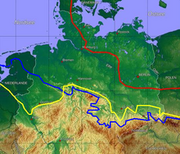
Ice age map of northern Germany and its northern neighbours. Red: maximum limit of Weichselian glacial; yellow: Saale glacial at maximum (Drenthe stage); blue: Elster glacial maximum glaciation.
Rocks from the earliest well established ice age, called the Huronian, formed around 2.4 to 2.1 Ga (billion years) ago during the early Proterozoic Eon. Several hundreds of km of the Huronian Supergroup are exposed 10–100 km north of the north shore of Lake Huron extending from near Sault Ste. Marie to Sudbury, northeast of Lake Huron, with giant layers of now-lithified till beds, dropstones, varves, outwash, and scoured basement rocks. Correlative Huronian deposits have been found near Marquette, Michigan, and correlation has been made with Paleoproterozoic glacial deposits from Western Australia. The Huronian ice age was caused by the elimination of atmospheric methane, a greenhouse gas, during the Great Oxygenation Event.[11]
The next well-documented ice age, and probably the most severe of the last billion years, occurred from 720 to 630 million years ago (the Cryogenian period) and may have produced a Snowball Earth in which glacial ice sheets reached the equator,[12] possibly being ended by the accumulation of greenhouse gases such as CO
2 produced by volcanoes. "The presence of ice on the continents and pack ice on the oceans would inhibit both silicate weathering and photosynthesis, which are the two major sinks for CO
2 at present."[13] It has been suggested that the end of this ice age was responsible for the subsequent Ediacaran and Cambrian explosion, though this model is recent and controversial.
The Andean-Saharan occurred from 460 to 420 million years ago, during the Late Ordovician and the Silurian period.

Sediment records showing the fluctuating sequences of glacials and interglacials during the last several million years.
The evolution of land plants at the onset of the Devonian period caused a long term increase in planetary oxygen levels and reduction of CO
2 levels, which resulted in the late Paleozoic icehouse. Its former name, the Karoo glaciation, was named after the glacial tills found in the Karoo region of South Africa. There were extensive polar ice caps at intervals from 360 to 260 million years ago in South Africa during the Carboniferous and early Permian Periods. Correlatives are known from Argentina, also in the center of the ancient supercontinent Gondwanaland.
The Quaternary Glaciation / Quaternary Ice Age started about 2.58 million years ago at the beginning of the Quaternary Period when the spread of ice sheets in the Northern Hemisphere began. Since then, the world has seen cycles of glaciation with ice sheets advancing and retreating on 40,000- and 100,000-year time scales called glacial periods, glacials or glacial advances, and interglacial periods, interglacials or glacial retreats. The earth is currently in an interglacial, and the last glacial period ended about 10,000 years ago. All that remains of the continental ice sheets are the Greenland and Antarctic ice sheets and smaller glaciers such as on Baffin Island.
The definition of the Quaternary as beginning 2.58 Ma is based on the formation of the Arctic ice cap. The Antarctic ice sheet began to form earlier, at about 34 Ma, in the mid-Cenozoic (Eocene-Oligocene Boundary). The term Late Cenozoic Ice Age is used to include this early phase.[14]
Ice ages can be further divided by location and time; for example, the names Riss (180,000–130,000 years bp) and Würm (70,000–10,000 years bp) refer specifically to glaciation in the Alpine region. The maximum extent of the ice is not maintained for the full interval. The scouring action of each glaciation tends to remove most of the evidence of prior ice sheets almost completely, except in regions where the later sheet does not achieve full coverage.
Glacials and interglacials[]
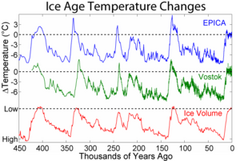
Shows the pattern of temperature and ice volume changes associated with recent glacials and interglacials
Within the ice ages (or at least within the current one), more temperate and more severe periods occur. The colder periods are called glacial periods, the warmer periods interglacials, such as the Eemian Stage.
Glacials are characterized by cooler and drier climates over most of the earth and large land and sea ice masses extending outward from the poles. Mountain glaciers in otherwise unglaciated areas extend to lower elevations due to a lower snow line. Sea levels drop due to the removal of large volumes of water above sea level in the icecaps. There is evidence that ocean circulation patterns are disrupted by glaciations. Since the earth has significant continental glaciation in the Arctic and Antarctic, we are currently in a glacial minimum of a glaciation. Such a period between glacial maxima is known as an interglacial. The glacials and interglacials also coincided with changes in Earth's orbit called Milankovitch cycles.
The earth has been in an interglacial period known as the Holocene for around 11,700 years,[15] and an article in Nature in 2004 argues that it might be most analogous to a previous interglacial that lasted 28,000 years.[16] Predicted changes in orbital forcing suggest that the next glacial period would begin at least 50,000 years from now, due to the Milankovitch cycles. Moreover, anthropogenic forcing from increased greenhouse gases is estimated to potentially outweigh the orbital forcing of the Milankovitch cycles for hundreds of thousand of years.[17][5][4]
Positive and negative feedback in glacial periods[]
Each glacial period is subject to positive feedback which makes it more severe, and negative feedback which mitigates and (in all cases so far) eventually ends it.
Positive feedback processes[]
Ice and snow increase Earth's albedo, i.e. they make it reflect more of the sun's energy and absorb less. Hence, when the air temperature decreases, ice and snow fields grow, and this continues until competition with a negative feedback mechanism forces the system to an equilibrium. Also, the reduction in forests caused by the ice's expansion increases albedo.
Another theory proposed by Ewing and Donn in 1956[18] hypothesized that an ice-free Arctic Ocean leads to increased snowfall at high latitudes. When low-temperature ice covers the Arctic Ocean there is little evaporation or sublimation and the polar regions are quite dry in terms of precipitation, comparable to the amount found in mid-latitude deserts. This low precipitation allows high-latitude snowfalls to melt during the summer. An ice-free Arctic Ocean absorbs solar radiation during the long summer days, and evaporates more water into the Arctic atmosphere. With higher precipitation, portions of this snow may not melt during the summer and so glacial ice can form at lower altitudes and more southerly latitudes, reducing the temperatures over land by increased albedo as noted above. Furthermore, under this hypothesis the lack of oceanic pack ice allows increased exchange of waters between the Arctic and the North Atlantic Oceans, warming the Arctic and cooling the North Atlantic. (Current projected consequences of global warming include a largely ice-free Arctic Ocean within 5–20 years, see Arctic shrinkage.) Additional fresh water flowing into the North Atlantic during a warming cycle may also reduce the global ocean water circulation. Such a reduction (by reducing the effects of the Gulf Stream) would have a cooling effect on northern Europe, which in turn would lead to increased low-latitude snow retention during the summer. It has also been suggested that during an extensive glacial, glaciers may move through the Gulf of Saint Lawrence, extending into the North Atlantic Ocean far enough to block the Gulf Stream.
Negative feedback processes[]
Ice sheets that form during glaciations cause erosion of the land beneath them. After some time, this will reduce land above sea level and thus diminish the amount of space on which ice sheets can form. This mitigates the albedo feedback, as does the lowering in sea level that accompanies the formation of ice sheets.[19]
Another factor is the increased aridity occurring with glacial maxima, which reduces the precipitation available to maintain glaciation. The glacial retreat induced by this or any other process can be amplified by similar inverse positive feedbacks as for glacial advances.[20]
According to research published in Nature Geoscience, human emissions of carbon dioxide (CO2) will defer the next ice age. Researchers used data on Earth's orbit to find the historical warm interglacial period that looks most like the current one and from this have predicted that the next ice age would usually begin within 1,500 years. They go on to say that emissions have been so high that it will not.[21]
Causes[]
The causes of ice ages are not fully understood for either the large-scale ice age periods or the smaller ebb and flow of glacial–interglacial periods within an ice age. The consensus is that several factors are important: atmospheric composition, such as the concentrations of carbon dioxide and methane (the specific levels of the previously mentioned gases are now able to be seen with the new ice core samples from EPICA Dome C in Antarctica over the past 800,000 years); changes in the earth's orbit around the Sun known as Milankovitch cycles; the motion of tectonic plates resulting in changes in the relative location and amount of continental and oceanic crust on the earth's surface, which affect wind and ocean currents; variations in solar output; the orbital dynamics of the Earth–Moon system; the impact of relatively large meteorites and volcanism including eruptions of supervolcanoes.[22]
Some of these factors influence each other. For example, changes in Earth's atmospheric composition (especially the concentrations of greenhouse gases) may alter the climate, while climate change itself can change the atmospheric composition (for example by changing the rate at which weathering removes CO
2).
Maureen Raymo, William Ruddiman and others propose that the Tibetan and Colorado Plateaus are immense CO
2 "scrubbers" with a capacity to remove enough CO
2 from the global atmosphere to be a significant causal factor of the 40 million year Cenozoic Cooling trend. They further claim that approximately half of their uplift (and CO
2 "scrubbing" capacity) occurred in the past 10 million years.[23][24]
Gallery[]
References[]
- ↑ Ehlers, Jürgen; Gibbard, Philip (2011). "Quaternary glaciation". Encyclopedia of Snow, Ice and Glaciers. Encyclopedia of Earth Sciences Series. pp. 873–882. doi:10.1007/978-90-481-2642-2_423. ISBN 978-90-481-2641-5.
- ↑ Cohen, K .M.; Finney, S. C.; Gibbard, P. L.; Fan, J.-X.. "International Chronostratigraphic Chart 2013". ICS. http://www.stratigraphy.org/icschart/chronostratchart2013-01.pdf. Retrieved 7 January 2019.
- ↑ Imbrie, J.; Imbrie, K. P. (1979). Ice ages: solving the mystery. Short Hills NJ: Enslow Publishers. ISBN 978-0-89490-015-0. https://archive.org/details/iceagessolvingmy0000imbr.
- ↑ 4.0 4.1 "Global Warming Good News: No More Ice Ages". LiveScience. 2007. https://www.livescience.com/1846-global-warming-good-news-ice-ages.html.
- ↑ 5.0 5.1 "Human-made climate change suppresses the next ice age". Potsdam Institute for Climate Impact Research in Germany. 2016. https://www.pik-potsdam.de/news/press-releases/human-made-climate-change-suppresses-the-next-ice-age.
- ↑ (2004-09-20) "How are past temperatures determined from an ice core?". Scientific American.
- ↑ (2010) "Glacier advance in southern middle-latitudes during the Antarctic Cold Reversal". Nature Geoscience 3 (10): 700–704. DOI:10.1038/ngeo962.
- ↑ Lockwood, J.G. (November 1979). "The Antarctic Ice-Sheet: Regulator of Global Climates?: Review". The Geographical Journal 145 (3): 469–471. DOI:10.2307/633219.
- ↑ Warren, John K. (2006). Evaporites: sediments, resources and hydrocarbons. Birkhäuser. p. 289. ISBN 978-3-540-26011-0. https://books.google.com/?id=ihny39BvVhIC&pg=PA289.
- ↑ Allaby, Michael (January 2013). A Dictionary of Geology and Earth Sciences (Fourth ed.). Oxford University Press. ISBN 9780199653065. https://oxfordindex.oup.com/view/10.1093/acref/9780199653065.013.3641.
- ↑ Kopp, Robert (14 June 2005). "The Paleoproterozoic snowball Earth: A climate disaster triggered by the evolution of oxygenic photosynthesis". PNAS 102 (32): 11131–6. DOI:10.1073/pnas.0504878102. PMID 16061801.
- ↑ (May 2000) "Neoproterozoic 'snowball Earth' simulations with a coupled climate/ice-sheet model". Nature 405 (6785): 425–9. DOI:10.1038/35013005. PMID 10839531.
- ↑ Chris Clowes (2003). ""Snowball" Scenarios of the Cryogenian". Paleos: Life through deep time. Archived from the original on 15 June 2009. https://web.archive.org/web/20090615181543/http://www.palaeos.com/Proterozoic/Neoproterozoic/Cryogenian/Snowballs.html.
- ↑ University of Houston-Clear Lake - Disasters Class Notes - Chapter 12: Climate Change sce.uhcl.edu/Pitts/disastersclassnotes/chapter_12_Climate_Change.doc
- ↑ (2009) "Formal definition and dating of the GSSP (Global Stratotype Section and Point) for the base of the Holocene using the Greenland NGRIP ice core, and selected auxiliary records". J. Quaternary Sci. 24 (1): 3–17. DOI:10.1002/jqs.1227.
- ↑ (2004-06-10) "Eight glacial cycles from an Antarctic ice core". Nature 429 (6992): 623–8. DOI:10.1038/nature02599. PMID 15190344.
- ↑ "Next Ice Age Delayed By Rising Carbon Dioxide Levels". 2007. https://www.sciencedaily.com/releases/2007/08/070829193436.htm. Retrieved 2008-02-28.
- ↑ Ewing, M. (1956-06-15). "A Theory of Ice Ages". Science 123 (3207): 1061–1066. DOI:10.1126/science.123.3207.1061. ISSN 0036-8075. PMID 17748617.
- ↑ Huddart, David; Stott, Tim A. (2013-04-16) (in en). Earth Environments: Past, Present and Future. John Wiley & Sons. ISBN 978-1-118-68812-0. https://books.google.com/?id=_64G6cYuz3AC&pg=PT1624&dq=%22lowering+in+sea+level+that+accompanies+the+formation+of+ice+sheets%22#v=onepage&q&f=false.
- ↑ Bennett, Matthew M.; Glasser, Neil F. (2010-03-29) (in en). Glacial Geology: Ice Sheets and Landforms. Wiley. ISBN 978-0-470-51690-4. https://archive.org/details/glacialgeologyic00benn_0. "Another factor is the increased aridity occurring with glacial maxima, which reduces the precipitation available to maintain glaciation. The glacial retreat induced by this or any other process can be amplified by similar inverse positive feedbacks as for glacial advances."
- ↑ Black, Richard (9 January 2012). "Carbon emissions 'will defer Ice Age'". BBC News. https://www.bbc.co.uk/news/science-environment-16439807. Retrieved 10 August 2012.
- ↑ Luthi, Dieter (2008-03-17). "High-resolution carbon dioxide concentration record 650,000–800,000 years before present". Nature 453 (7193): 379–382. DOI:10.1038/nature06949. PMID 18480821.
- ↑ (1991) "Plateau Uplift and Climate Change". Scientific American 264 (3): 66–74. DOI:10.1038/scientificamerican0391-66.
- ↑ Raymo, Maureen E. (1988-07-01). "Influence of late Cenozoic mountain building on ocean geochemical cycles" (in en). Geology 16 (7): 649–653. DOI:<0649:IOLCMB>2.3.CO;2 10.1130/0091-7613(1988)016<0649:IOLCMB>2.3.CO;2. ISSN 0091-7613.
External links[]
- Cracking the Ice Age from PBS
- Montgomery, Keith (2010). "Development of the glacial theory, 1800–1870". http://glacialtheory.net. Historical Simulation
- Raymo, M. (July 2011). "Overview of the Uplift-Weathering Hypothesis". http://www.moraymo.us/uplift_overview.php.
- Eduard Y. Osipov, Oleg M. Khlystov. Glaciers and meltwater flux to Lake Baikal during the Last Glacial Maximum.
- Black, R. (9 January 2012). "Carbon emissions 'will defer Ice Age'". BBC News: Science and Environment. https://www.bbc.co.uk/news/science-environment-16439807.
